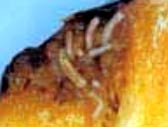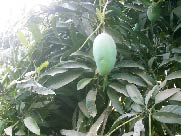|
Mango
Mango fruit fly is hitting hard to the mango growers in sindh
Hadi Bux Leghari
Common name: Mango fruit fly
scientific name: Bactrocera (formerly Dacus) dorsalis (Hendel) (Insecta: Diptera: Tephritidae)
Fruit flies are an important group of insects damaging mango fruits in the various mango-areas of the world.
The mango fruit fly is being observed in Sindh during this year especially on Sindhri, Chaunsa and Sonara cultivars. Mango growers are yet unfortunately unaware about this harmful insect pest of mango fruit; they are already overwhelmed from the damage that was done by powdery mildew and inflorescence anthracnose, the estimated loss from these diseases could exceed from 40 to 60% in Sindh and the mango fruit fly will further aggravate this problem.
It can bring some heavy losses to the mango growers; so far agriculture extension workers are not seen on the ground for education to the mango growers of Sindh. What are fruit flies? Fruit flies are bigger than common houseflies and are red black, or yellow in color, depending upon the species; but all species are similar, indeed almost the same, in their mode of infection, reproductive and damage they cause.
The fly selects a mature fruit for egg laying with its sharp, pointed, long ovipositor; it punctures the skin and lays the eggs in the pulp. Usually the fly lays 100-150 eggs in its entire life; although I have seen fruits having 400-600 eggs laid inside them, it seems to me that such a large complement might have been laid not by one but by a number of flies. The eggs are tiny and white in color and hatch in one or two days.
The maggots are white, broader at the posterior end and pointed at the anterior end. When fully grown they measure about half inch in length. By the time the maggots attain their full development, the fruit rots and drops down. For pupation maggot leave the affected fruit and disperse, making an arch of their body by bringing the two ends together and then jumping. Pupation occurs in the soil, the period lasts for 7-10 days. The adult live from only a few to 300 days, or even longer. The carry-over of the pest is from one host to another and winter is passed in adult and pupal stage. (Maggot 1mm in length) (Pupae 1.3mm) (Affected mango fruit in pulp is of 3cm).
Symptoms:
Attacked fruits usually show signs of oviposition punctures. Fruits with high sugar content exude a sugary liquid, which usually solidifies adjacent to the oviposition site.

Eggs inside the mango fruit
|

Damaged mango fruit
|
Detection and inspection methods:
B. zonata can be monitored by traps (Jackson or Steiner traps, though Jackson traps are preferable) baited with the male lure methyl eugenol (O-methyl eugenol), which attracts male flies at very low concentrations and insecticide. In Jackson traps, a cotton wick impregnated with about 6 mL of a mixture methyl-eugenol: insecticide (3:1) is placed inside the trap. Malathion or dichlorvos is generally used as the killing agent. Traps are usually placed in fruit-bearing trees inside the canopy at about two-thirds of the tree height. For detection activities, "sentinel" traps should be located at all potential points of entry (seaport, airport, border crossing…) while in commercial orchards traps should be set at a rate of 1 trap per km2. The mixture methyl-eugenol: malathion usually remains effective in the field for one month and traps would need to be serviced twice a month.
Ovipostion preferences by fruit fly on following mango cultivars:
1. Bagan Pali
2. Desi
3. Sindhri
4. Landra
5. Chounsa
6. Sonara
7. Almsas
Control:
To reduce the infestation of these flies, the affected dropped fruits should be collected daily and destroyed.
For control of fruit flies the pheromone trap (methyl-eugenol 85%, naled (insecticides) 5%, and 10% saturated sugar) solution that attracts males can be useful.
Bait recommended for these flies is 2-2 and half oz. of sodium silicofluroide, or lead arsenate and 2 lbs sugar in 4 gallons of water. It may either hung on trees in cigarette tins containing projecting wicks. Or may be sprayed on the tree.
The number of traps are 8/acre and installed each trap at the height of 6-8 ft. Trapping should be done from Feb to March then May to June and September to October against Bacterocera zordis and B. dorsalis.Diptrex insecticide should also be used.
Phytosanitary risk:
EPPO originally mentioned B. zonata as an A1 quarantine pest within the broad category "non-European Trypetidae" (OEPP/EPPO, 1983) and B. zonata is of quarantine significance to APPPC, CAN, CPPC, JUNAC and OIRSA. In a later review by EPPO, it was decided that it was no longer necessary to mention B. zonata specifically. The species is known by experience to have the potential to establish adventives populations in tropical areas (Mauritius, Réunion).
It was, however, considered to be exclusively tropical and the countries where B. zonata occurs are those where the generally more damaging species B. dorsalis is also found (EPPO/CABI, 1996). However, B. zonata is now established and widespread in Egypt (Hashem et al., 2001), and has therefore demonstrated its ability to establish outside tropical conditions and adapt to local conditions (Iwahashi and Routhier, 2001).
Risk analysis has already suggested that B. zonata can establish in other countries of the Mediterranean region, although it is not sure which. The EPPO Workshop on B. zonata (Paris, 2002-03) recommended that B. zonata should be added to the EPPO A1 quarantine list. Pakistani mangoes are banned in Japan, Turkey and USA due to the fruit fly so therefore we should take some appropriate measures against fruit fly in order to capture international mango markets.
|